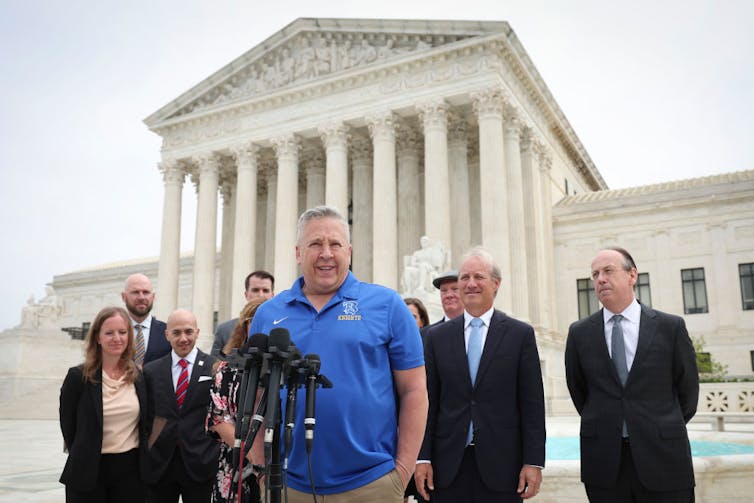Source: The Conversation – in French – By Lewis Mattin, Senior Lecturer, Life Sciences, University of Westminster
Les fibres sont essentielles, c’est incontestable. Mais dans le monde des tendances santé en ligne, ce qui était au départ un conseil alimentaire judicieux s’est transformé en « fibremaxxing », une tendance qui consiste à consommer des quantités astronomiques de fibres au nom du bien-être.
Au Canada, les recommandations suggèrent que les femmes ont besoin de 25 grammes de fibres par jour et les hommes 38 grammes de fibres par jour. Les enfants et les adolescents ont généralement besoin de beaucoup moins.
Pourtant, malgré des recommandations claires, la plupart des Canadiennes et Canadiens n’atteignent pas leur objectif quotidien en matière de fibres. L’un des principaux responsables ? L’essor des aliments ultra-transformés. Pas moins de 46 % de l’apport énergétique quotidien consommé au pays en 2015 provenait d’aliments ultratransformés. Les enfants étaient d’ailleurs les plus grands consommateurs.
Quand les bons aliments disparaissent de nos assiettes
Les aliments ultra-transformés sont généralement pauvres en fibres et en micronutriments, tout en étant riches en sucre, en sel et en graisses malsaines. Lorsque ces aliments dominent notre assiette, les aliments complets naturellement riches en fibres sont évincés.
Des études montrent que plus la consommation d’aliments ultra-transformés augmente, plus la consommation de fibres diminue, ainsi que celle d’autres nutriments essentiels. Il en résulte une population qui est loin d’atteindre son objectif quotidien en matière de fibres.
Les fibres alimentaires sont essentielles à une bonne santé dans le cadre d’une alimentation équilibrée. On les trouve principalement dans les aliments d’origine végétale.
Ajouter des aliments riches en fibres à vos repas et collations tout au long d’une journée type, par exemple en optant pour du pain complet au petit-déjeuner, en conservant la peau des fruits comme les pommes, en ajoutant des lentilles et des oignons à un chili pour le dîner et en mangeant une poignée de graines de citrouille ou de noix du Brésil entre les repas, aiderait une personne moyenne à atteindre ses besoins quotidiens de 30 g.
Consommer trop de fibres
Avec le fibremaxxing, ce qui pourrait rendre cette tendance quelque peu dangereuse, c’est le fait de supprimer d’autres groupes d’aliments tels que les protéines, les glucides et les lipides et de les remplacer par des aliments riches en fibres, des compléments alimentaires ou des poudres.
C’est là que le risque potentiel pourrait atténuer les avantages d’une augmentation de la consommation de fibres, car, à ma connaissance, aucune étude solide n’a été menée chez l’homme sur la consommation à long terme de plus de 40 g de fibres par jour. (Certains partisans du « fibremaxxing » recommandent de consommer entre 50 et 100 g par jour.)
Déjà des milliers d’abonnés à l’infolettre de La Conversation. Et vous ? Abonnez-vous gratuitement à notre infolettre pour mieux comprendre les grands enjeux contemporains.
Consommer trop de fibres trop rapidement, surtout sans boire suffisamment d’eau, peut entraîner des ballonnements, des crampes et de la constipation. Cela peut également provoquer une accumulation de gaz qui peut aussi entraîner des flatulences au mauvais moment, comme pendant les trajets quotidiens.

William Perugini/Shutterstock
Une augmentation rapide de la consommation de fibres ou une consommation excessive peut interférer avec l’absorption de micronutriments essentiels tels que le fer, qui soutient le fonctionnement normal de l’organisme, ainsi que des macronutriments, qui fournissent l’énergie nécessaire au mouvement, à la réparation et à l’adaptation.
Pas que des inconvénients
Cependant, il est important de se rappeler que l’augmentation de la quantité de fibres dans votre alimentation offre de nombreux avantages pour la santé. Elles favorisent un système digestif sain en stimulant le transit intestinal et en réduisant l’apparition de maladies inflammatoires de l’intestin.
Les fibres solubles aident à réguler la glycémie en ralentissant l’absorption du glucose, ce qui les rend particulièrement utiles pour les personnes à risque de diabète de type 2. Elles réduisent également le taux de cholestérol LDL (mauvais cholestérol), ce qui diminue le risque de maladies cardiaques. Les fibres procurent une sensation de satiété plus longue, ce qui favorise une gestion saine du poids et la régulation de l’appétit. Ces résultats sont tous bien documentés.
De plus, une alimentation riche en fibres a été associée à un risque moindre de certains cancers, en particulier le cancer du côlon, car elle aide à éliminer efficacement les toxines de l’organisme. Augmenter progressivement votre consommation de fibres jusqu’à atteindre les niveaux recommandés, grâce à une alimentation équilibrée et variée, peut avoir de réels bienfaits pour la santé.
Au vu des preuves, il est clair que beaucoup d’entre nous pourraient tirer profit d’une consommation plus importante de fibres, mais dans la limite du raisonnable.
En attendant d’en savoir plus, il est plus prudent de respecter les recommandations actuelles en matière de consommation de fibres et de les consommer sous forme naturelle plutôt que sous forme de poudres ou de compléments alimentaires. Les fibres sont essentielles, mais il ne faut pas nécessairement en consommer davantage.
Ignorez les modes sur les réseaux sociaux et privilégiez l’équilibre : céréales complètes, légumes, noix et graines. Votre intestin – et vos compagnons de trajet – vous en remercieront.
![]()
Lewis Mattin est affilié à la Physiological Society, à la Society for Endocrinology, à In2Science et au réseau Ageing and Nutrient Sensing Network financé par l’UKRI.
– ref. Le « fibremaxxing » est à la mode. Voici pourquoi cela pourrait poser problème – https://theconversation.com/le-fibremaxxing-est-a-la-mode-voici-pourquoi-cela-pourrait-poser-probleme-262282


















